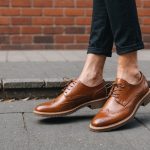Understanding Comfort in Work Shoes
Attaining comfort in work shoes is essential for promoting well-being during lengthy work hours. One crucial element is arch support. Proper arch support in ergonomic footwear alleviates foot fatigue by distributing pressure across the feet evenly. This support also minimizes potential foot pain, ensuring readiness for day-to-day challenges.
Cushioning plays a vital role in ensuring comfort. It absorbs shocks from walking or standing on hard surfaces, reducing strain on joints. Quality cushioning serves both function and comfort, providing a plush walking experience throughout the workday.
Topic to read : Unlock your confidence with playful lingerie store online
Breathable materials significantly enhance comfort. These materials allow air circulation within professional footwear, preventing excessive sweating and maintaining a pleasant temperature around the feet. Moreover, breathable shoes contribute to overall hygiene, lessening the risk of odours and related discomforts.
Another aspect is the fit of the shoe. A well-fitting shoe prevents blisters and promotes movement without restriction. When choosing ergonomic footwear, individuals should consider not only the size but also the shoe’s shape and width.
This might interest you : How can you achieve a fashionable look while staying comfortable?
In summary, prioritizing arch support, cushioning, breathable materials, and a well-suited fit collectively defines the comfort standard in professional footwear, addressing both the physiological needs and overall satisfaction for wearers.
Key Features to Look for in Work Shoes
Understanding the features of work shoes is vital for ensuring durability and functionality. A critical feature to consider is slip resistance. In busy work environments, especially where surfaces are often wet, slip-resistant shoes prevent accidents and provide security. This feature is necessary for occupations where safety standards are non-negotiable.
Next, consider the longevity of materials. Durable materials, like leather or high-quality synthetics, guarantee that the shoes withstand daily wear. The benefit here is double-fold: saving money long-term and reducing environmental impact. Shoes made from durable materials tend to also offer better protection against everyday hazards.
Balancing aesthetics with functional attributes presents an exciting challenge but is also rewarding. Professional footwear doesn’t need to compromise on style. Many contemporary work shoes seamlessly blend trendy designs with essential features, like strong grip soles and reinforced toes. Fashion doesn’t need to be sacrificed for utility.
In your search for the ideal work shoe, remember to evaluate these essential attributes. They ensure that shoes not only complement your wardrobe but also meet high-performance standards needed for demanding workdays.
Fashion Trends in Work Shoes
In the exciting world of fashion-forward footwear, trendy work shoes are increasingly bridging the gap between style and functionality. Today, workplaces are embracing contemporary styles that reflect current fashion trends, allowing individuals to express themselves without compromising professionalism. This shift is evident in sleek designs that often feature streamlined silhouettes and chic details.
Professional shoe trends are evolving with vibrant colors and bold patterns gaining popularity in office settings. While traditional blacks and browns remain a staple, hues such as navy, olive, and even subtle metallics are becoming fashion staples in work environments. Patterns like plaid and pinstripes add uniqueness and a touch of personality to professional wardrobes.
The influence of these trends on work shoe choices is significant. Many individuals now seek shoes that complement personal style while providing essential support and safety. Thus, trendy work shoes blend practicality with aesthetics, offering versatile options for various professional contexts. This harmonious mix ensures that individuals look good while feeling comfortable and protected, ultimately enhancing satisfaction and confidence in their work attire.
Brand Recommendations for Work Shoes
Finding the right work shoes often means relying on reputable brands recognized for quality and durability. Within the UK market, several popular work shoe brands stand out for their commitment to these standards.
Leading Brands in the Market
- Dr. Martens offers sturdy, stylish footwear suitable for various work environments, blending innovation with tradition.
- Clarks is renowned for its classic designs and impeccable craftsmanship, ensuring comfort and longevity.
- Skechers provides a range of ergonomic footwear designed for prolonged use, ideal for those on their feet all day.
Brand Comparisons and Price Points
While prices vary, it’s essential to find a balance between cost and the longevity of the product. Dr. Martens, for instance, may come with a higher initial price but justifies this with exceptional durability. Clarks sits in a mid-range price point, offering reliable quality without breaking the bank. Skechers provides budget-friendly options with a focus on contemporary design and comfort.
Customer Reviews and Reliability
These brands frequently receive positive reviews for both style and performance, earning them a reputation as some of the best brands for work shoes. Their reliability and customer satisfaction contribute significantly to their popularity in professional settings.
Comparing Different Types of Work Shoes
Navigating the array of types of work shoes can be daunting. Each category serves unique needs and environments, offering distinct advantages and drawbacks.
Formal work shoes exude sophistication and are ideal for corporate settings. These shoes often feature polished leather and classic designs, providing a professional appearance. However, they may lack the flexibility desired in more dynamic roles.
Casual work shoes strike a balance between comfort and style, suitable for more relaxed or creative environments. Typically crafted from softer materials, they support all-day wear with ease but may not deliver the level of professionalism required in strictly formal workplaces.
Sport-style work shoes prioritize comfort and functionality. Engineered for active roles, these shoes deliver robustness and foot support. While perfect for roles demanding physical activity, their athletic appearance might clash with formal dress codes.
When choosing, priorities should align with job requirements. For office settings, formal shoes may be essential, while casual shoes suit more flexible environments. Sport-style shoes cater to active jobs where comfort and support eclipse appearance. Balancing these considerations with personal style ensures the selection of appropriate footwear for any professional context.
Retailers and Where to Buy Work Shoes
Finding the best retailers for work shoes is crucial for securing footwear that meets both quality and style expectations. In the UK, several retailers, both online and in-store, excel in offering a diverse range of options catering to varied professional needs.
Online work shoe shopping provides the convenience of browsing extensive collections from home, with retailers like Zalando and ASOS leading the charge by offering user-friendly platforms and wide selections. Their digital services often include customer reviews and size guides, aiding informed decisions.
On the other hand, shopping at brick-and-mortar retailers like John Lewis and Clarks offers the invaluable experience of trying on shoes for the perfect fit. These stores provide an opportunity to assess comfort directly, offering a tactile shopping experience that online avenues cannot replicate.
For those seeking trend offerings, local boutiques in various cities often feature unique styles not found in larger chains. These shops can provide personalized service, catering to specific style preferences and ensuring the latest fashion-forward footwear is available.
To maximize your purchase, explore sales and discounts, which frequently occur online and in physical stores, allowing you to balance cost while acquiring high-quality shoes.
Pricing Considerations for Quality Work Shoes
When considering work shoe pricing, understanding the value of investing in quality footwear is crucial. Quality brands often come with a higher price tag, yet they deliver long-term benefits that justify the expenditure. For instance, shoes crafted from premium materials generally offer added durability and support, leading to fewer replacements over time.
The spectrum of prices varies significantly across the market. Cost-effective shoes can sometimes be found within budget lines, but these may lack the longevity or comfort that higher-priced alternatives provide. It’s important to weigh the immediate financial savings against possible future costs, such as frequent replacements or potential discomfort.
Strategically timing purchases to coincide with sales and discounts can make obtaining durable footwear more affordable. Seasonal sales or special promotions offer opportunities to purchase high-quality shoes at reduced prices, allowing buyers to maximise their budget for work shoes. Also, exploring outlet stores or clearance sections of reputable retailers can sometimes yield excellent deals on premium brands.
Balancing cost and quality doesn’t simply involve choosing the cheapest option. It requires thoughtful consideration of durability, material quality, and overall comfort to ensure long-lasting satisfaction and optimal value from your work shoe investment.
Tips for Maintaining Work Shoes
Proper upkeep of work shoes maximizes their lifespan and benefits wearers. To extend shoe life, regular maintenance is crucial, starting with consistent cleaning. Different materials require unique care approaches. For example, leather shoes benefit from occasional conditioning and polish to maintain their sheen and flexibility. In contrast, fabric and synthetic materials should be carefully spot-cleaned with mild soap and water, ensuring no harsh chemicals that might degrade materials are used.
Regular shoe inspections help catch potential issues early. Checking for wear on soles, stitching, and insoles preserves the structural integrity of the footwear. This proactive strategy aids in avoiding costly repairs or replacements by addressing minor problems before they exacerbate.
Proper storage conditions also impact longevity. Keeping shoes in a cool, dry place prevents moisture build-up and protects against environmental damage. Using shoe trees or maintaining the original shape with crumpled paper ensures that the footwear retains its form and fit.
Incorporating these shoe maintenance tips into regular routines ensures both the appearance and functional support of work shoes remain optimal for the rigours of everyday use, thus enhancing comfort and performance in professional settings.











